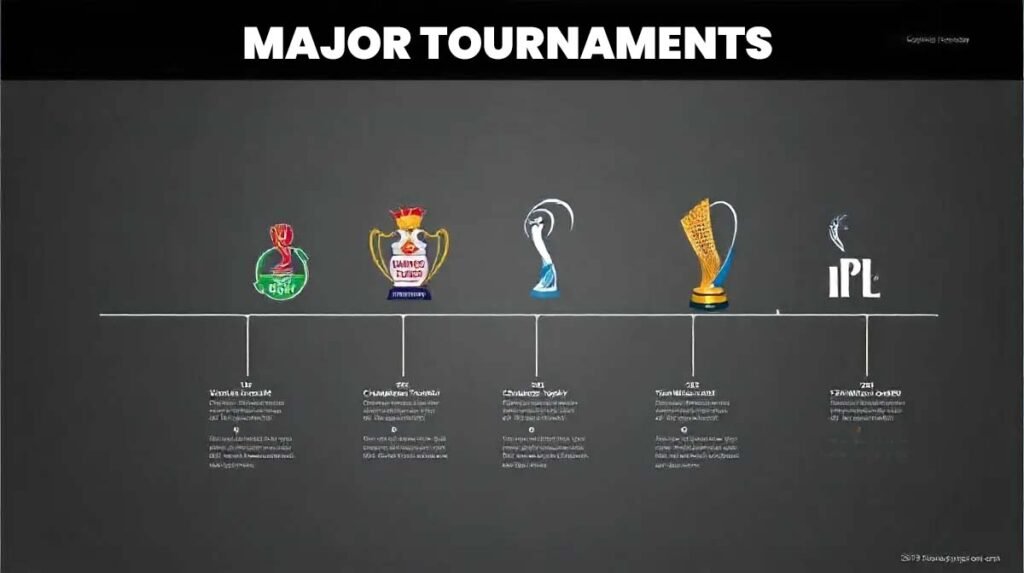Cricket History: Cricket, often dubbed the “gentleman’s game,” boasts a storied history that stretches over four centuries. From its modest origins in the English countryside to its stature as a global phenomenon with millions of enthusiasts by 2025, cricket has undergone remarkable transformations. This article offers a detailed exploration of cricket’s history, tracing its journey from a leisurely pursuit to a fiercely competitive and commercialized sport. We’ll delve into pivotal events, influential figures, and groundbreaking innovations that have defined cricket’s evolution, complemented by vivid imagery to bring this narrative to life.
Origins of Cricket
Cricket’s beginnings are veiled in some mystery, with theories suggesting it may have descended from earlier bat-and-ball games played in England or even Europe. The earliest concrete evidence of cricket as an adult sport emerges in 1611, when two men in Sussex faced prosecution for playing on a Sunday instead of attending church—an incident that underscores both the game’s early appeal and its capacity to ruffle societal feathers.
Likely born during Saxon or Norman times in the Weald—a region of woodlands and clearings in southeast England—cricket started as a children’s game. By the 17th century, it had captured adult interest, with the first recorded organized match occurring in 1646. As the game spread across southern England, it gained a foothold as a popular pastime.
A landmark moment arrived in 1787 with the founding of the Marylebone Cricket Club (MCC) in London. The MCC swiftly emerged as the guardian of cricket’s laws and traditions, standardizing rules, introducing the concept of the “over,” and establishing Lord’s Cricket Ground as the sport’s hallowed heart. The MCC’s “Laws of Cricket,” though refined over time, remain the bedrock of the game’s governance.

Cricket History: Development in England
The 18th and 19th centuries marked cricket’s blossoming in England, fueled by the rise of county cricket and the birth of legendary rivalries. The first documented inter-county match pitted Kent against Surrey in 1709, setting the stage for the formal County Championship, which launched in 1890.
Perhaps the most iconic chapter in this era began in 1882 with the Ashes series. Following Australia’s stunning victory over England at The Oval, The Sporting Times published a satirical obituary lamenting the death of English cricket, declaring that “the ashes” would be taken to Australia. This sparked the enduring England-Australia rivalry, symbolized by a tiny urn, which remains one of cricket’s most cherished traditions.
This period also saw the game’s rules and equipment evolve. The shift from underarm to overarm bowling, legalized in 1864, transformed bowling techniques and laid the groundwork for modern playstyles. Pads, gloves, and improved bats further refined the sport, enhancing both safety and skill.

Spread to Other Countries
Cricket’s global journey began in the 19th century, propelled by British colonialism. It took root in nations like Australia, India, the West Indies, and South Africa, each weaving the sport into its cultural fabric.
- Australia: Cricket arrived Down Under in 1803, with the first Test match—also the world’s inaugural Test—played against England in Melbourne in 1877. Australia’s cricketing stature soared, cementing its status as a powerhouse by the early 20th century.
- India: Introduced by British sailors in the 18th century, cricket found a foothold with the establishment of the Calcutta Cricket Club in 1792. India’s love affair with the game deepened, leading to its first Test in 1932 and landmark World Cup triumphs in later decades.
- West Indies: In the Caribbean, cricket became a unifying force, with the West Indies debuting in Test cricket in 1928. Legends like Sir Garfield Sobers and Sir Vivian Richards propelled the region to dominance in the 1970s and 1980s.
- South Africa: Cricket took hold by 1808, with South Africa’s first Test played in 1889. Despite interruptions due to apartheid, the nation has since re-emerged as a formidable cricketing force.
The International Cricket Council (ICC), founded in 1909 as the Imperial Cricket Conference, formalized cricket’s global governance. Over time, it expanded its reach, welcoming new nations and orchestrating international competitions.

Evolution of Formats
Cricket’s formats have adapted over time, reflecting shifting audience tastes and commercial demands.
- Test Cricket: The classic format, Test cricket features matches lasting up to five days, with each team batting twice. The first official Test, between Australia and England in 1877, set the standard for this enduring style.
- One Day Internationals (ODIs): Debuting in 1971, ODIs capped each team at 50 overs, offering a faster, more decisive contest. The Cricket World Cup, launched in 1975, catapulted this format to global prominence.
- Twenty20 (T20): Introduced in 2003, T20 cricket shrank matches to 20 overs per side, prioritizing speed and spectacle. Its runaway success spawned leagues like the Indian Premier League (IPL) and the ICC T20 World Cup, first held in 2007.
T20’s rise has redefined cricket, drawing younger fans and transforming it into a worldwide entertainment juggernaut, while Test cricket retains its prestige as the game’s purest form.

Major Tournaments
Cricket’s marquee tournaments have elevated its global stature, blending competition with cultural resonance.
- Cricket World Cup: Launched in 1975, the ODI World Cup is the zenith of 50-over cricket. Australia’s five titles and England’s dramatic 2019 win exemplify its prestige.
- ICC Champions Trophy: Initiated in 1998, this tournament pits the top eight ODI teams against each other. Memorable victories include India’s in 2013 and Pakistan’s in 2017.
- ICC T20 World Cup: Since 2007, this biennial event has showcased T20’s dynamism. The West Indies’ consecutive wins in 2012 and 2016 highlight their mastery of the format.
- Indian Premier League (IPL): Starting in 2008, the IPL redefined cricket with its franchise model, drawing elite players and massive audiences. Its influence has inspired leagues like Australia’s Big Bash and the Caribbean Premier League.
These events have boosted cricket’s commercialization, turning it into a year-round spectacle with billions of viewers.

Recent Developments (2000-2025)
The 21st century has ushered cricket into a new era, marked by technology, inclusivity, and global expansion.
- Technology in Cricket: The Decision Review System (DRS), introduced in 2008, leverages ball-tracking and ultra-edge to refine umpiring decisions. Analytics and wearable tech have also reshaped training and tactics.
- Women’s Cricket: The women’s game has surged, buoyed by greater investment and visibility. The ICC Women’s World Cup and the Women’s IPL have spotlighted stars like Mithali Raj and Ellyse Perry.
- T20 Leagues: Beyond the IPL, leagues such as the Big Bash, Caribbean Premier League, and Pakistan Super League have proliferated, offering constant cricketing action and lucrative opportunities.
- Global Outreach: Cricket has pushed into new territories, like the United States and China. Its inclusion in the 2028 Los Angeles Olympics signals a bold step toward universal appeal.
By 2025, cricket continues to innovate, with debates over four-day Tests, an expanded T20 World Cup, and AI-driven coaching and broadcasting shaping its trajectory.

Conclusion
Cricket’s odyssey from a rural English game to a global sport by 2025 reflects its remarkable adaptability and enduring charm. It has bridged cultures and continents, uniting fans through a shared passion. As it evolves, cricket balances innovation with its storied traditions, ensuring its relevance for future generations.
From that first match in 1646 to the electrifying T20 leagues of 2025, cricket has celebrated skill, strategy, and camaraderie. Its journey—rich with triumphs, rivalries, and reinventions—promises a vibrant future as the gentleman’s game continues to captivate the world.




Pingback: IPL History Till 2025: Full List of IPL Winners, Top Players & Records - Firsts Post